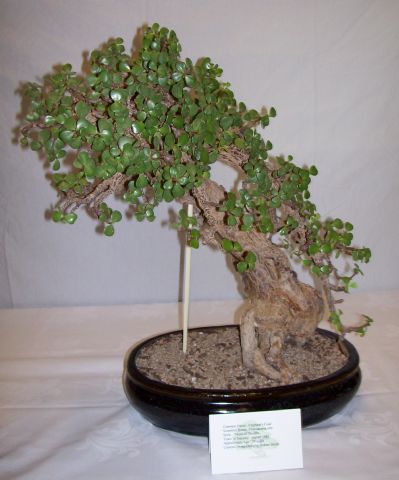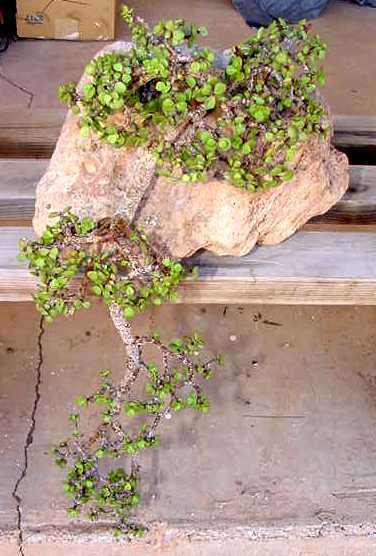
|

|
|
|
|
Estimated age 55 years; in training since
at least 1982.
Currently 17" tall, 10" diameter base,
in a 13"W x 9"D x 3"H blue glazed oval pot.
|
This tree was a gift to
me from Bill Mooney of the Phoenix Bonsai Society in May 1987 near the
end of my first club year there. He had had it for about five years,
but couldn't see a particular style in it. When Bill saw the way
I was gawking at this wild specimen which he'd brought to a workshop but
had not trimmed (I'm not sure I'd ever seen a
Portulacaria
that size before), he simply gave it to me to deal with rather than having to
lug it back to his yard. (His generosity is only surpassed by his
continued claims to a tree when it later starts to look good...)
The apex at the time was actually an overgrown branch growing right below the point at which the original trunk had been severed. It took me a couple of years to start to see some particular style in the tree, and it wasn't one of the modern traditional styles, but an old one from China. This Elephant Food was first publically displayed in February 1994 at our club's largest annual show. Overheard comments made by some visitors concerning the gnarly roots encouraged me that this tree was worth showing again. It has been shown at every Matsuri since then up through 2002, plus a few times as part of our Arizona State Fair display and once or twice at the Arizona Buddhist Church's Obon. When I did a book signing for Designing Dwarfs in the Desert at Borders Bookstore in Glendale, AZ in July 1998, this was the tree with which I explained the basics of our art. |

|

|
|
|
|

|
|
|
|
|

|
|
|
|
I finally saw how this "fit"
with a nice oval pot in February 1999, long after a few other club members
had. The bluish gray rock at the bottom left is actually three times
larger than what is visible here and is placed to keep the tree propped
up at the desired angle.
The tree at last was getting some long growth on the right side, which I had hoped to develop into a nicely ramified section to balance out the left side. (In February 2001 the final dangling two inches or so were removed.)
In early May 2002 and now
outside of Kingman, AZ, I discovered that one particular new bud was developing
as
a trio of pads
-- not the usual pair of opposing leaves.
This particular bud was so unique in its numeration that I had to study
it for a few days in a row before I actually believed what I was seeing.
Slightly rounder than the usual leaves, there was no other distinguishing
visible difference. A month and a half later the triplets were still
doing fine (each was 6 mm from base to apex and 6 to 7 mm wide, evenly
spaced around the central base) and a new bud further down this small branchlet
was just a usual pair of leaves. I wanted the trio's bud to grow
out into a decent sized branchlet of its own -- sacrificing "perfect" tree
shape if necessary for a few seasons -- and possibly root it at some point.
The beginnings of a sport?
- - - - -
Two of the long branches
in the picture on the top left were rooted about 1988. They were
allowed to grow to about 4 feet in length and then in 1998 were finally
begun to be made into cascades in their own right. One is in a standard
cylindrical dark Japanese earthenware cascade pot with a slight flaring
lip.
It BLOOMED in June 2003!
The
other (below) is in a pumice block. This one has been displayed a
few times in Phoenix and twice in Kingman to date.
|

|
|

|
|
|
Recently initially wired by Ernest Hasan (For the record, wire was removed Nov. 2002) |
|
|
June 2005 update: This pumice rock cascade Portulacaria now resides on a file cabinet right next to a second-floor south-facing doctor's office window near the hospital in Kingman. The doc has some experience with Elephant's food and the tree is resting comfortably. The other cascade which bloomed a couple of years back is now in the capable hands of Craig & Anita Cowing in New York state (it was a wedding present to them). Also, some club members might remember the unique "two guys fishing" double-arch cascade Portulacaria I had c.2000. This is now in the possession of the chief of the Kingman Fire Department who has had some experience with plants. These cascades received new caretakers because I knew we would be hard-pressed for space during and after the move to Colorado. Stay tuned... |